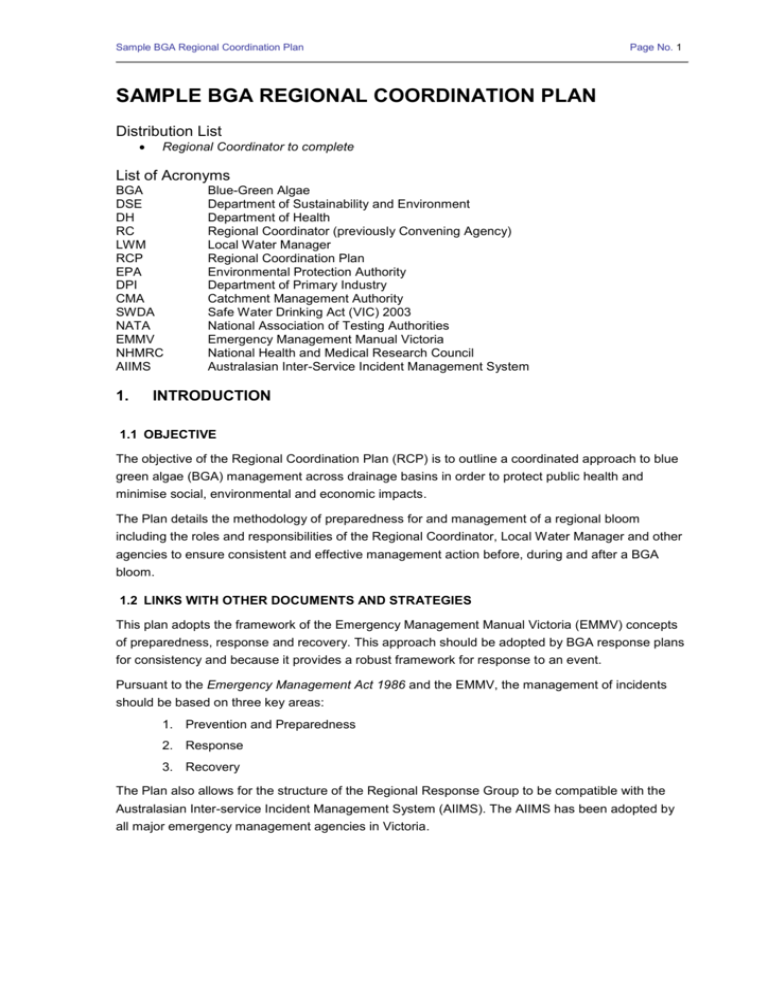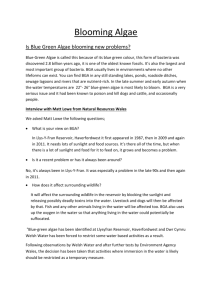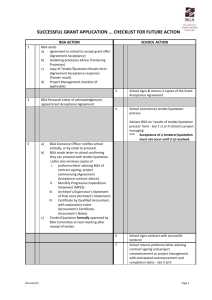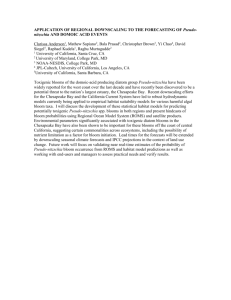Sample BGA Regional Coordination Plan
advertisement

Sample BGA Regional Coordination Plan Page No. 1 SAMPLE BGA REGIONAL COORDINATION PLAN Distribution List Regional Coordinator to complete List of Acronyms BGA DSE DH RC LWM RCP EPA DPI CMA SWDA NATA EMMV NHMRC AIIMS 1. Blue-Green Algae Department of Sustainability and Environment Department of Health Regional Coordinator (previously Convening Agency) Local Water Manager Regional Coordination Plan Environmental Protection Authority Department of Primary Industry Catchment Management Authority Safe Water Drinking Act (VIC) 2003 National Association of Testing Authorities Emergency Management Manual Victoria National Health and Medical Research Council Australasian Inter-Service Incident Management System INTRODUCTION 1.1 OBJECTIVE The objective of the Regional Coordination Plan (RCP) is to outline a coordinated approach to blue green algae (BGA) management across drainage basins in order to protect public health and minimise social, environmental and economic impacts. The Plan details the methodology of preparedness for and management of a regional bloom including the roles and responsibilities of the Regional Coordinator, Local Water Manager and other agencies to ensure consistent and effective management action before, during and after a BGA bloom. 1.2 LINKS WITH OTHER DOCUMENTS AND STRATEGIES This plan adopts the framework of the Emergency Management Manual Victoria (EMMV) concepts of preparedness, response and recovery. This approach should be adopted by BGA response plans for consistency and because it provides a robust framework for response to an event. Pursuant to the Emergency Management Act 1986 and the EMMV, the management of incidents should be based on three key areas: 1. Prevention and Preparedness 2. Response 3. Recovery The Plan also allows for the structure of the Regional Response Group to be compatible with the Australasian Inter-service Incident Management System (AIIMS). The AIIMS has been adopted by all major emergency management agencies in Victoria. Sample BGA Regional Coordination Plan 2. Page No. 2 DEFINITIONS Definitions to be consistent with DSE Blue-Green Algae Circular. Blue Green Algae Bloom: An increase in algal numbers to such an extent as to: discolour the water, impart taste, odours, toxins and/or other compounds to the water, to adversely affect the other biotic components of the aquatic ecosystem (ie fish, birds, amphibians, etc) or generally render the water unsuitable for its intended use (ie drinking, irrigation, recreation, stock watering, ecosystem maintenance etc). (Queensland Harmful Algal Bloom Response Plan Version 1 Dec 2002) Local Bloom - Confined to a single water body. Regional BGA Bloom – Affects multiple interconnected water bodies and algae is present at the public health alert levels as defined in the DSE Blue-Green Algae Circular. Drinking Water - Water that is intended for human consumption or for purposes connected with human consumption, such as the preparation of food or the making of ice for consumption or for the preservation of unpackaged food, whether or not the water is used for other purposes (Safe Drinking Water Act 2003). Recreational Water Bodies - Any areas where a significant number of people use the water for recreation (NHMRC 2008). The recreational trigger levels defined in the DSE Blue-Green Algae Circular are based on primary contact recreation. Primary Contact Recreation: Includes all water-related activities where immersion in water is the intended action or probable outcome of the activity (for example swimming, water skiing, surfing or whitewater canoeing). 3. SCOPE 4. Basins, water bodies covered by RCP (to be completed by Regional Coordinator) History of blooms (to be completed by Regional Coordinator) ROLES AND RESPONSIBILITIES Roles and responsibilities to be consistent with DSE Blue-Green Algae Circular. 4.1 SUMMARY OF ROLES AND RESPONSIBILITIES The roles and responsibilities of all parties in the management of blue-green algae, based on the EMMV incident management approach is summarised in Figure 1 below. Sample BGA Regional Coordination Plan P r e v e n t i o n P r e p a r e d n e s s Statewide Coordinator (DSE) Regional Coordinator (RC) Local Water Manager (LWM) Identify high risk water bodies/ reaches with Regional Coordinators Liaise with CMAs and LWMs regarding Water Quality Plans to reduce risk of blooms Review BGA risk for water body/reach and determine and implement any preventative measures CMAs develop Regional River Health Strategy Maintain database of history of BGA blooms to monitor trends RCs liaise with CMAs and others to encourage river and catchment improvement works Prepare, update annually Risk Management Plans and Incident Response Plans Tourism Victoria to assist with preparation of the tourism industry for BGA Blooms Prepare, update annually and distribute Regional Coordination Plan (RCP) Monitor and sample for BGA in accordance with Risk Management Plan Convene pre-season co-ordination Meeting and undertake exercise exercise to test RCPs and Incident/Risk Management plans Participate in preseason Regional Coordination Meeting and undertake exercise to test plans Be informed of local blooms Report to RC, DSE and and DH local blooms (where required) Annual update DSE BGA Circular Ensure RCs have prepared and updated Regional Coordination Plans Assist RCs in allocation of LWMs if required R e s p o n s e Page No. 3 Monthly summary reports on significant blooms (on DSE website) Declare a bloom regional Liaise with DH where required Provide advice to appropriate Minister where required Manage regional blooms in accordance with RCP Convene response group Manage local blooms in accordance with Incident Response Plan including monitoring, signage, media releases Notify the RC if a local bloom has or becomes a Regional Bloom Appoint Incident Controller Develop: Communication Plan Operations Plan Monitoring plan Participate in regional bloom Response Group as required Ensure Debrief Report is prepared for blooms above the public health alert level Prepare debrief report for regional blooms DH provides input to BGA Circular DH, EPA Operations, DPI, CMAs members of regional bloom Response Group DH provides advice on public health and seafood safety with respect to BGA DH is control Agency for drinking water contamination in EMMV Emergency Services if bloom becomes an emergency as defined in EMMV Tourism Victoria provides contacts in the relevant Regional Tourism Response and Recovery Group Report to DSE and DH R e c o v e r y Support Agency Prepare Debrief Report for blooms above the public health alert level Annual BGA Report for season Figure 1: Summary of BGA Coordination Roles and Responsibilities DH assessment of social and environmental impacts in accordance with EMMV Sample BGA Regional Coordination Plan Page No. 4 4.2 ROLES AND RESPONSIBILITIES IN THE REGIONAL COORDINATION PLAN Roles and responsibilities to be consistent with DSE Blue-Green Algae Circular. Department of Sustainability and Environment – is the Statewide Coordinator for blue-green algae management. DSE collects data on blue-green algae to monitor trends throughout the State to assist in the management of blue-green algae. Department of Health (DH) - provides advice about the potential public health effects of algae blooms and enforces the Victorian Safe Drinking Water Act 2003. Regional Coordinators - oversee the management of local blooms, nominate local water managers and coordinate preparations for and the management of regional blooms. Local Water Managers (LWMs) - Responsible for the management of blue-green algae blooms in a local water body. LWM’s are responsible for developing a Risk Management Plan for water bodies under their responsibility and to monitor for signs of blue-green algae in accordance with this Plan. LWM’s are also responsible for the development and implementation of Incident Response Plans. The Plans shall be reviewed annually and shall link to the Regional Coordination Plan. Refer Appendix 2 for list of Local Water Managers and areas of responsibility. A template for a standard Risk Management and Incident Response Plan is available from DSE. Regional Response Group - manage regional blooms on a continuing basis on behalf of the Regional Coordinators. The Regional Coordinator is responsible for convening the Response Group. The Response Group may consist of the following personnel: Representatives of the Regional Coordinator (usually Incident Controller but the role can be delegated with agreement of the Response Group) Representatives of the impacted Local Water Managers Relevant Catchment Management Authority Department of Sustainability and Environment Parks Victoria Department of Human Services Victorian Environment Protection Authority Municipal Councils Department of Primary Industries Other affected stakeholders Refer Appendix 3 for Response Group Members Incident Controller - Based on the Australasian Inter-Service Incident Management System (AIIMS) and the EMMV, the Incident Controller assumes overall responsibility for the management of the incident and is supported by three sections: Planning, Operations and Logistics, if required. The Regional Coordinator representative will fill the role of the Incident Controller, unless delegated with agreement of the Response Group. The supporting roles of Planning, Operations and Logistics may be serviced by varying members of the response group depending on the location of the regional bloom Planning Officer (if required) - is responsible for Incident Action Planning, resource tracking and provision of incident information and situation reports Sample BGA Regional Coordination Plan Page No. 5 Operation Officer (if required) - is responsible for implementation of the Incident Action Plan Logistics Officer (if required) – is responsible for the provision of services in support of the incident Control Agency - in accordance with the Emergency Management Manual Victoria (EMMV), the control agency is the agency nominated to control the response activities. 5. Support Agency - in accordance with the Emergency Management Manual Victoria (EMMV), a support agency provides services, personnel or material to support or assist in response activities. TASKS 5.1 PRESEASON PREPARATION 5.1.1 Review of Response Plans The Regional Coordination Plan is to be reviewed annually to ensure: the Plan reflects the current state of knowledge in relation to BGA management the contacts list is current; and the Plan is consistent with the latest DSE Blue-Green AIgae Circular . The Plan is to be distributed to those listed in the distribution list. Local Water Mangers shall annually review the Risk Management and Incident Response Plans and provide to the Regional Coordinators. 5.1.2 Pre-Season Meeting A pre-season regional coordination meeting shall be organised with members of the Response Group. Items to be discussed at this meeting include: DSE BGA Circular Overview of high risk water bodies and any risk reduction strategies Local Water Manager Risk Management and Incident Response Plans Regional Coordination Plan Season preparation (ie training, resources) Exercise to test Regional Coordination Plan 5.1.3 Provision of updated Plans The updated Regional Coordination Plan shall be provided to DSE. The updated Local Water Manager Incident Response Plans shall be provided to the Regional Coordinator. Sample BGA Regional Coordination Plan Page No. 6 5.2 RESPONSE Once a Regional Bloom has been identified, the Response Group shall be convened and undertake the tasks shown in Figure 2. Appoint Incident Controller Planning Officer (if required) Operations Officer (if required) Logistics Officer (if required) Develop and implement Incident Action Plan Communication Plan Operations Plan Monitoring Plan 1. External Communication 1. Water Uses/Users 1. Establish Program Assessment of exposed population to the bloom (township supplies, recreational users, rural domestic users, stock, other) Responsible water authority required to manage the risks in accordance with drinking water quality risk management plan Selection of sampling sites Determination of appropriate communication measures (signage, media releases, call centre, website) Determination of communication message 2. Management Options Floating booms to minimise scum movement Air curtains to improve water body mixing 2. Internal Communication Manipulating river flows to increase river mixing Exchange contact details of Response Group Identification of substitution water bodies Allocate tasks within Response Group Maintaining signage Determine information required to be circulated and frequency of exchange 3. Treatment Options Algicides require consultation with the EPA and only appropriately registers (or permitted) products can be used Figure 2: Summary of Response Group Responsibilities Parameters to be monitored Frequency of sampling Selection of laboratory Action levels Responsible LWMs Cost sharing principles 2. Review of Monitoring Data Sample BGA Regional Coordination Plan Page No. 7 5.3 DEBRIEFING (RECOVERY) At the conclusion of a regional blue-green algae bloom, the Response Group shall meet to evaluate the management of the bloom and the efficiency of the Plan. The Debrief Report is to be provided to the Regional Coordinator and DSE. 6. REPORTING OF BLUE GREEN ALGAE Reporting to be consistent with DSE Blue-Green Algae Circular. 6.1 NOTIFICATION TO DSE AND REGIONAL COORDINATOR When sampling and testing has confirmed the existence of BGA at or in excess of a biovolume of 0.2mm3/L, LWMs are asked to advise the Regional Coordinator and the DSE. The Water Industry Portal (http://waterportal.dse.vic.gov.au/WIPHome.aspx) should be used for this notification. A login for this website can be obtained by contacting the DSE Blue-Green Algae State Coordinator (refer to Appendix D for contact details). Once logged into the website the details of the bloom can be recorded. The Regional Coordinator and the DSE will be able to view the details of the bloom via this database. If you are experiencing problems with the Water Industry Portal website please contact the DSE State-wide Coordinator. 6.1.1 Local Blooms When reporting local blooms, LWMs are requested to provide advice via the portal (or notification form) as to whether the bloom: has already been notified to DSE and the information provided is an update on the bloom status. LWMs are asked to enter bloom updates as new results become available and when the bloom has ceased; is likely to become a regional problem; has caused a water supply to be interrupted, public warnings to be issued or water bodies to close; and will or has resulted in the need to treat a water body with an algicide 6.1.2 Regional Blooms When reporting regional blooms, Response Groups should provide advice, similar to a local bloom. Response Groups are asked to advise the Regional Coordinator and the DSE. 6.2 ADDITIONAL NOTIFICATIONS Additional notifications to be consistent with DSE Blue-Green Algae Circular In some circumstances, other organisations, groups or individuals will need to be notified of BGA blooms. This will depend on the use of the water body and density and nature of the bloom. These additional notifications are illustrated in the flowchart in Figure 2 and discussed in more detail in this section. 6.2.1 Drinking Water Blue-green algal blooms in drinking water supplies that may pose a risk to public health or may result in widespread public complaint (for example through taste and odour) must be notified to the DH using the notification arrangements under Section 22 of the SDWA. This notification should be made immediately via telephone (on 1300 761 874 during business hours or 1300 790 733 after hours) and followed up with written notification using the formal notification form (refer to Guidance Note No. 7: Notifications Required under the SDWA, available from (www.health.vic.gov.au/environment/water/d-guidelines). Sample BGA Regional Coordination Plan Page No. 8 DH must be notified when: Water supplied for drinking1 may place public health at risk due to one or more of the following: Total microcystins are detected at ≥1.3 ug/L (microcystin-LR toxicity equivalents) Microcystis aeruginosa is present at ≥ 6,500 cells/mL Total combined biovolume of known toxic cyanobacterial species ≥ 0.6 mm 3/L Total combined biovolume of all cyanobacterial species ≥ 10 mm 3/L OR BGA are present in drinking water at levels that may cause widespread public complaint, for example through taste and odour. As water storage managers (as defined under the SDWA) do not generally treat and supply drinking water to the public in Victoria, they may not be best placed to determine whether BGA in the raw water of a drinking water supply may place public health at risk. This means that the water supplier (as defined under the SDWA) may be the most appropriate entity to notify DH of BGA incidents under Section 22. As there are exceptions to this generalisation, and the SDWA places obligations on both water storage managers and water suppliers, this Circular cannot be prescriptive about who should notify DH of Section 22 incidents. In all cases, DH expects the Risk Management Plans of the water storage manager and water supplier to be integrated such that a suitable communication protocol is in place. This protocol must clearly outline how details of BGA blooms are communicated between the water storage manager and water supplier, and who will notify DH if such a notification is required. This is a requirement under the Safe Drinking Water legislation. A recommended framework for monitoring and managing BGA in drinking water supplies can be found in Management Strategies for Cyanobacteria (BGA): a Guide for Water Utilities (Water Quality Research Australia 2010). 6.2.2 Recreational Water Notifications are required when a blue-green algal bloom poses a health risk in water bodies used for primary contact recreation. Blooms in recreational water bodies are considered to pose a potential public health risk, for primary contact recreation, when one or more of the following is true: ↘ ↘ ↘ ↘ Microcystis aeruginosa is present at ≥ 50,000 cells/mL Total combined biovolume of known toxic cyanobacterial species is ≥ 4 mm 3/L Total combined biovolume of all cyanobacterial species is ≥ 10 mm3/L Cyanobacterial scums are consistently present In the case of these algal blooms, the following groups should be notified: ↘ Recreational users of the water body (for example, through signage or media, as appropriate). ↘ DH (on 1300 761 874 during business hours). ↘ Relevant stakeholders (such as local government, tourism bodies and recreation clubs). 1 DH does not need to be notified where: Drinking water is not, or has not been, supplied from the water body during the period when the algal bloom occurred (i.e. the water body has been isolated from supply). Drinking water treatment processes are in place that will effectively remove blue-green algal toxins or the potential cause of widespread public complaint. Sample BGA Regional Coordination Plan Page No. 9 Additional information on, and a framework of alert levels for monitoring and managing blue-green algae risks in recreational water bodies can be found in the Guidelines for Managing Risks in Recreational Water (NHMRC 2008). 6.2.3 Other Water Supplies Currently there is insufficient data to set risk-based trigger levels for BGA in water bodies used for other purposes, such as stock and domestic supplies or irrigation water. The LWM should undertake a risk assessment for blue-green algal blooms in these water bodies to determine whether the water is potentially hazardous. If it is considered that a risk may be posed due to the presence of BGA, then all relevant users of the water should be notified. For domestic water uses (such as showering and bathing, cooking or other kitchen purposes and domestic garden watering), the use of the drinking water trigger levels for BGA are recommended. While this is likely to be conservative, it can be used in the absence of a more detailed risk assessment for the specific scenario in question. Sample BGA Regional Coordination Plan Page No. 10 APPENDICES Appendix 1 Incident Management Response Levels Appendix 2 Responsible Local Water Managers for each water body/reach (to be completed by Regional Coordinator) Appendix 3 Response Group members (to be completed by Regional Coordinator) Appendix 3 Water Testing Laboratories (NATA accredited) (refer Appendix C DSE Blue-Green Algae Circular) (to be completed by Regional Coordinator if required Appendix 4 Web based data entry address BGA Notification Form (DSE) (refer DSE website www.ourwater.vic.gov.au/monitoring/monthly/blue-green_alage) (to be completed by Regional Coordinator) Appendix 5 Materials and Equipment held by Local Water Managers (to be completed by Regional Coordinator if required) Appendix 6 Media Outlets (to be completed by Regional Coordinator) Appendix 7 Public Update Distribution List (to be completed by Regional Coordinator) Sample BGA Regional Coordination Plan APPENDIX 1 INCIDENT MANAGEMENT RESPONSE LEVELS Page No. 11 Sample BGA Regional Coordination Plan Page No. 12 Risk based management of BGA blooms for DRINKING WATER or RAW WATER (BULK WATER RESERVOIRS) supplies (DSE 2008) Incident Management Level (and characteristics of blooms) Consequences of Bloom Control Agency Monitoring Required Field Actions Required Communication Response 1 Minor Local Water Manager None Inform DSE Inform Regional Coordinator Local Water Manager Routine cell count monitoring Visual Observations of extent and potential for off-site contamination Increase monitoring BGA cell counts (frequency) Toxicity testing Visual Observations of extent and potential for off-site contamination Erect Signs on Site Alter treatment Inform DH (as per section 7.3.1 in BGA circular) Inform DSE Inform Regional Coordinator Notify other concerned agencies Inform Press and users Increase monitoring BGA cell counts (frequency and locations) Toxicity testing Visual Observations of extent and potential for off-site contamination As per Emergency Management Plan Bloom detected and 3 ≥ 0.2 mm /L BioVolume 2 Moderate 3 ≥ 0.4 mm /L BioVolume Toxic BGA or >5000 cells/ml Microcystis aeroginosa or >1.3µg/L microcystins or May have waterway environmental or potential public health impacts. Can be dealt with by on site resources of a single agency There is no adverse publicity, injury, or environmental impacts No involvement of the Emergency Services Adverse publicity May have waterway environmental or potential public health impacts. Can be dealt with by on site resources of a single agency 3 >10 mm /L BioVolume Total BGA and One location 3 Major Adverse publicity Could involve substantial risk of serious injury or death, may have serious environmental impacts, or could have public health implications. Executive level management of the issues and implications that may flow from the event. Needs the resources of multiple agencies to deal with issues and actions Catastrophic As per Emergency Management Plan Emergency due to the actual or imminent occurrence of an event which in any way endangers or threatens to endanger the safety or health of any person in Victoria or which destroys or damages, or threatens to destroy or damage any property in Victoria, including, without limiting the generality of the foregoing. 3 ≥ 0.4 mm /L BioVolume Toxic BGA or >5000 cells/ml Microcystis aeroginosa or >1.3µg/L microcystins or 3 >10 mm /L BioVolume Total BGA and Many Locations Emergency Many Locations Regional Coordinator Dept of Human Services Erect Signs on Site Alter management to avoid BGA Alter treatment to reduce risk As per Emergency Management Plan Inform DH(as per section 7.3.1 in BGA circular) Inform DSE Inform Regional Coordinator Notify other concerned agencies Inform Press and users Inform Public As per Emergency Management Plan Sample BGA Regional Coordination Plan Page No. 13 The actions suggested here are intended to guide the response to blue-green algae. Due to the varying toxicity and treatment of different blue-green algae species, each individual case will require an investigation and action plan. Risk based management of BGA blooms for RECREATIONAL WATER supplies Incident Management Level (and characteristics of blooms) Consequences of Bloom Control Agency Monitoring Required Field Actions Required Communication Response 1 Minor Routine cell count monitoring Visual Observations of extent and potential for off-site contamination None Inform DSE Inform Regional Co-ordinator Increase monitoring BGA cell counts (frequency) Toxicity testing Visual Observations of extent and potential for off-site contamination Erect Signs on Site Inform DH as per section 7.3.2 in BGA circular) Inform DSE Inform Regional Co-ordinator Notify other concerned agencies Inform Press and users Bloom detected and 3 ≥ 0.2 mm /L Biovolume 2 Moderate 3 ≥ 4 mm /L BioVolume Toxic BGA or >50,000 cells/ml Microcystis aeroginosa or May have waterway environmental or potential public health impacts. Can be dealt with by on site resources of a single agency There is no adverse publicity, injury, or environmental impacts No involvement of the Emergency Services Adverse publicity May have waterway environmental or potential public health impacts. Can be dealt with by on site resources of a single agency Local Water Manager Local Water Manager 3 >10 mm /L BioVolume Total BGA and One location 3 Major 3 ≥ 4 mm /L BioVolume Toxic BGA or >50,000 cells/ml Microcystis aeroginosa or 3 >10 mm /L BioVolume Total BGA and Many Locations Adverse publicity Could involve substantial risk of serious injury or death, may have serious environmental impacts, or could have public health implications. Executive level management of the issues and implications that may flow from the event. Needs the resources of multiple agencies to deal with issues and actions Regional Coordinator Increase monitoring BGA cell counts (frequency and locations) Toxicity testing Visual Observations of extent and potential for off-site contamination Erect Signs on Site Alter management to avoid BGA Alter treatment to reduce risk as per section 7.3.2 in BGA circular)Inform DSE Inform Regional Co-ordinator Notify other concerned agencies Inform Press and users Inform Public The actions suggested here are intended to guide the response to blue-green algae. Due to the varying toxicity and treatment of different blue-green algae species, each individual case will require an investigation and action plan.






